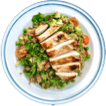
Interested in receiving new recipes?
Register your interest to access our free nutrition resources, recipes and information
It is not uncommon for people to lose weight as we age. However, this is not a desired part of ageing. In fact, research suggests that being overweight is not always associated with higher risk of death. Rather if older adults carry some extra weight then it helps them recover from illness. It also acts as a buffer during times when appetite might be poor.
Sometimes weight loss may be necessary. For example, to ease joint pain, or improve mobility. However, weight loss should not result in muscle loss. To ensure that this does not happen, get a special diet plan from an Accredited Practising Dietitian (APD).
Weight loss that is unexplained, unintended and unplanned is a cause of concern and must be assessed by your GP. Unexplained weight loss is often related to a loss of muscle. This has a negative effect on your strength, mobility and independence with day-to-day tasks. It is important that you monitor your weight regularly, particularly when you have been ill or had a reduced appetite. If you don’t have scales then pay attention to the fitting of your clothes and jewellery. Check if your clothes become loose, if you have to tighten your belt, or your rings are falling off your fingers. All these are signs of weight loss.
Have a look at the resource “Unintentional weight loss” for tips on preventing weight loss.

Food fortification is the process of adding nutrients to a food that the food would not naturally have.
For example, a banana is a good source of nutrients but it is not a source of protein. However, blend it with milk and the banana smoothie now has protein!
Food fortification can be helpful in older age. We know that older adults often have a small appetite. A small appetite increases the risk of not getting enough nutrients and therefore becoming deficient. By fortifying foods, you can increase the nutrition of each bite, without having to eat large amounts.
Simple steps such as adding milk powder to creamy soups and mashed potato and adding nuts on breakfast cereals and pasta are both cheap and effective. Another idea is to use milk instead of water when making soups and pasta sauces.
There are more suggestions on fortifying food in the resource “Food fortification – making every mouthful count”

It is well known that one-in-three older adults do not get enough protein. This is due to reduced appetite, chewing and swallowing issues, impaired sense of taste and smell and limited independence with shopping and cooking. A diet that is low in protein can have permanent effects on muscle and bone health. This can lead to weakness, aches and pains, increased risk of falls, and reduced quality of life.
There are many foods that are high in protein. A good place to start would be to find high protein foods that you love to eat. Next, ensure that at least one of these foods are in all of your meals each day.
Eggs are a full of protein and are a great addition to breakfast, pastas, desserts and soups. Having a few boiled eggs in the refrigerator can also result in a quick and easy snack.
Cheeses are available in huge varieties and can also be added to main meals and snacks. Cottage cheese can be added to lasagne, parmesan cheese can be added to soups, salads and pasta dishes, or sliced hard cheeses can be enjoyed with crackers.
The resource “How to eat more protein” has some more ideas.

Did you know that protein requirements are higher for older adults than for younger adults? The reason for this is that muscles in our body are always being broken down and rebuilt. Proteins are the building blocks of muscles. So, without enough dietary protein, the body will break down more muscle than it rebuilds. This will lead to reduced strength and being unable to carry out day-to-day activities of living independently. Reduced muscle strength will add to weakness and frailty, which compounds the risk for falls. Therefore, keeping muscle in the body is very important.
As you get older, a protein intake of 1.0-1.2g per kilogram of body weight per day is recommended. So, if a person weighs 65kg, their protein requirements are at least 65g per day. Or about 20-25g of protein at each main meal. To put this in perspective, 100g or cooked red meat, chicken or fish contains 25-30g of protein.
Have a look at the resource “How to eat more protein” to see if you’re getting enough.

Many older adults say they have reduced or no appetite during meals. It is often thought as a “normal” part of ageing due to the myth that food and nutrient requirements decrease with ageing. Nutrient requirements for vitamins and minerals remain unchanged. In fact, requirements for protein increase.
Many factors can cause a loss of appetite. These include reduced physical activity, medication, illness, loss of sense of taste and smell and difficulty with chewing or swallowing. Other factors include being unable to eat independently, loneliness and depression.
A reduced appetite can result in a decreased intake of food and nutrients. This can cause frailty, unplanned weight loss, nutrient deficiencies, risk of infections and falls, and reduced quality of life.
Here are some ways to improve appetite:
Have a look at the resource “Eating well with a small appetite” for more.

It is common for people with health issues to follow a special diet that limits sugar and/or fat. These health issues could be diabetes, high blood cholesterol or high blood pressure. Some believe that older people need less vitamins, minerals and protein. Although, requirements remain similar, or may increase when unwell. Older adults need more protein than younger people.
As a person ages their need for special diets should be reviewed by a health professional such as an Accredited Practising Dietitian (APD). A dietitian can check if these restrictions are still relevant, especially if unplanned weight loss occurs. Older adults could be reducing their food intake and the variety of foods to limit sugar and fat. This could lower intake of important nutrients such as proteins, vitamins and minerals.
Eating less essential nutrients, could also lead to muscle loss, and an increase in infections and falls. This is particularly true with older adults who may already be frail or unwell.
Eating a variety of foods from all food groups is important. This reduces the chance of missing out on any nutrients.

We often hear about eating a healthy and balanced diet. But what do these two words mean?
Different foods contain different nutrients. For example, red meats provide protein and iron, green leafy vegetables provide folate and citrus fruits provide vitamin C. In addition, dairy foods provide protein and calcium, and wholegrains provide B vitamins and dietary fibre. Fats and oils provide energy and essential vitamins A and D. Eating a wide range of foods increases the chance of getting all the nutrients that our body needs to stay healthy.
It is a myth that older people need less nutrients than younger people. In fact, vitamin and mineral requirements may increase when sick. Older adults require more protein and generally should not be on low fat diets.
Have a look at the resource “Key nutrients for older adults” for more.

DISCLAIMER:
The content on this website is not, and is not intended to be, medical advice, which should be tailored to your individual circumstances. Content is for your information only, and we advise that you exercise your own judgment before deciding to use the information provided. Professional medical advice should be obtained before taking action. Please see here for terms and conditions.

Select your desired option below to share a direct link to this page.
Your friends or family will thank you later.